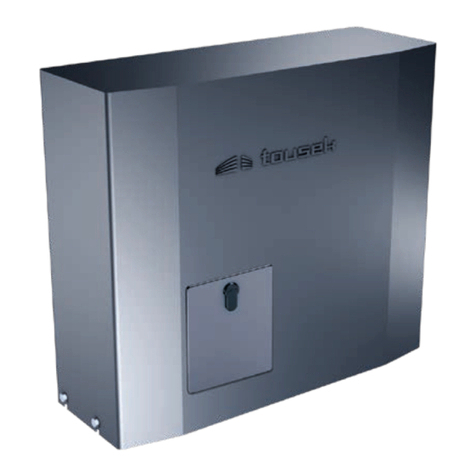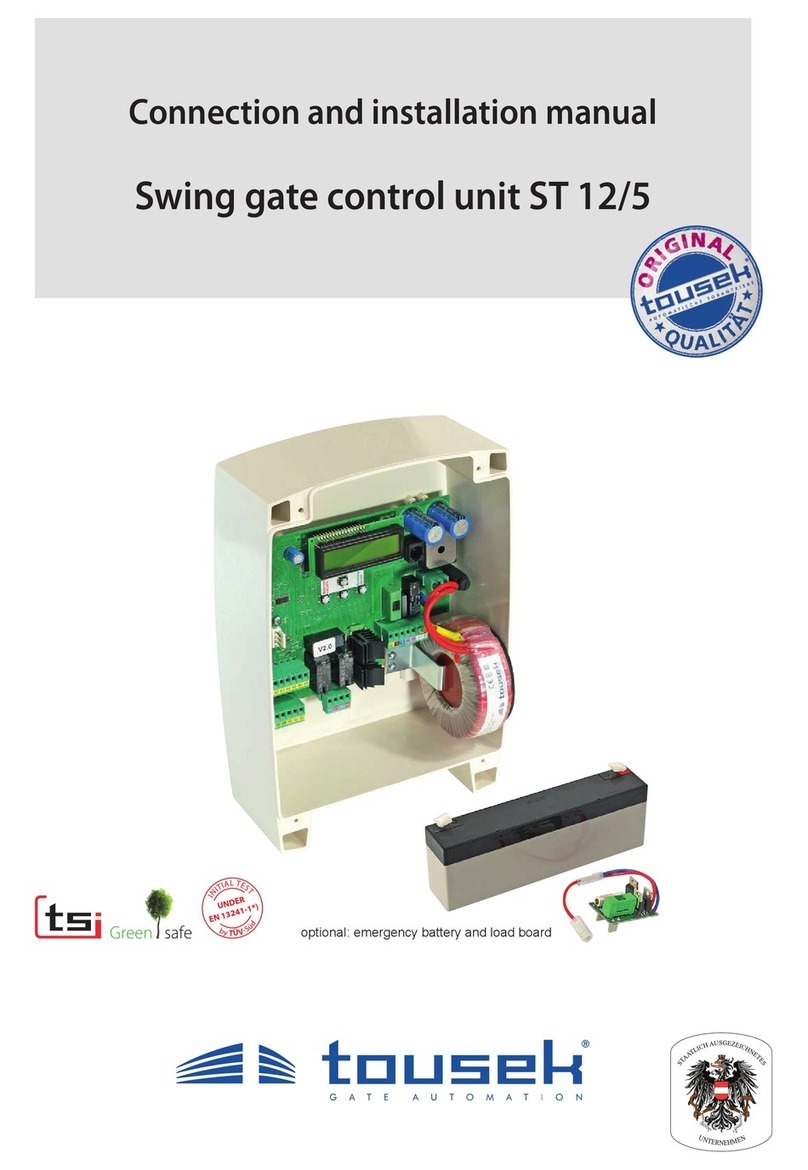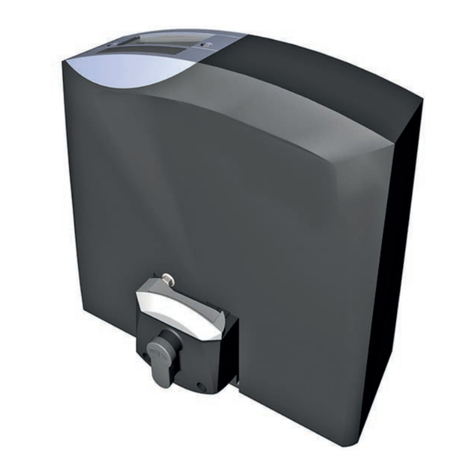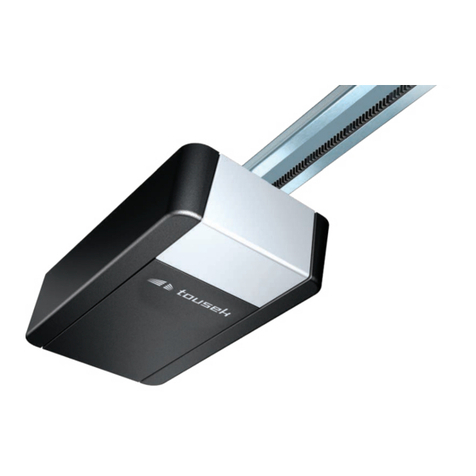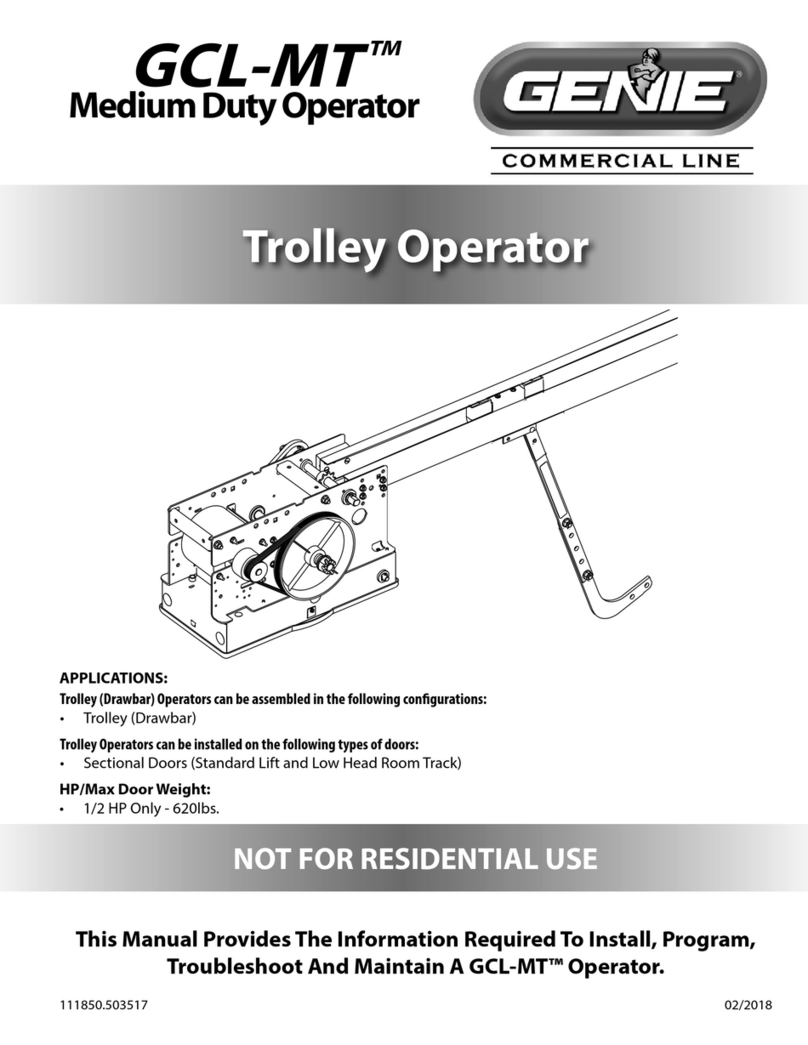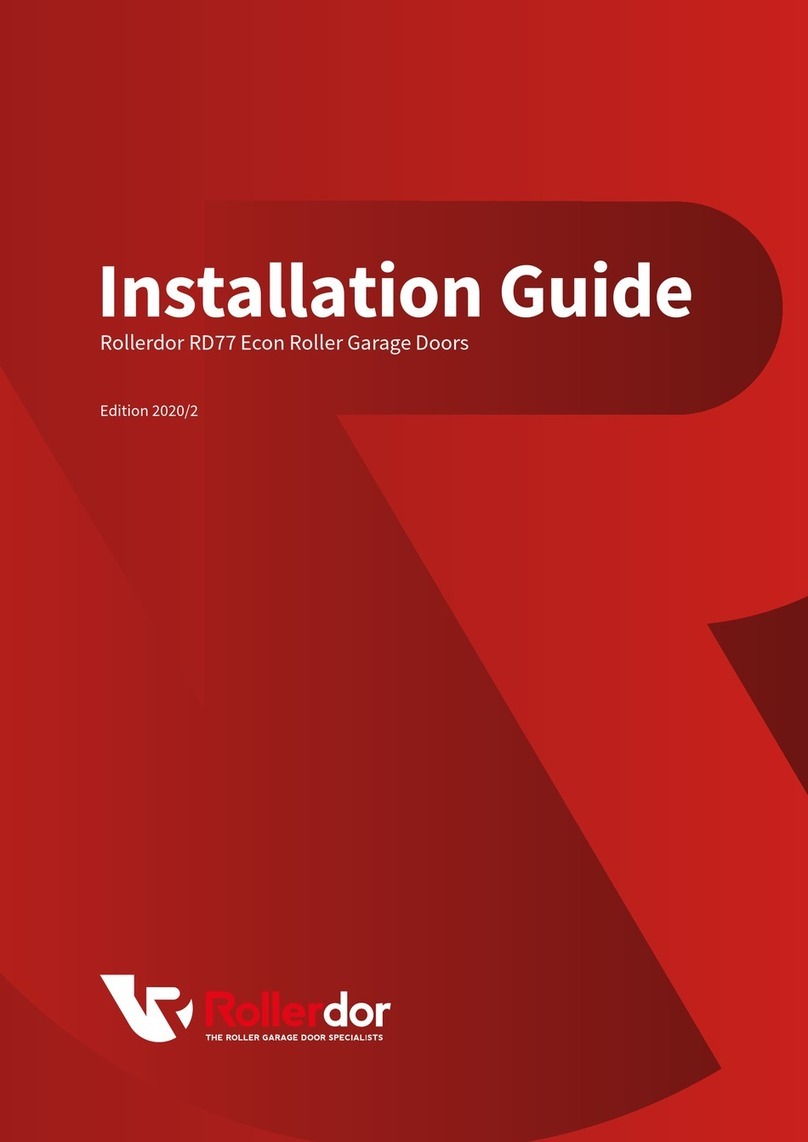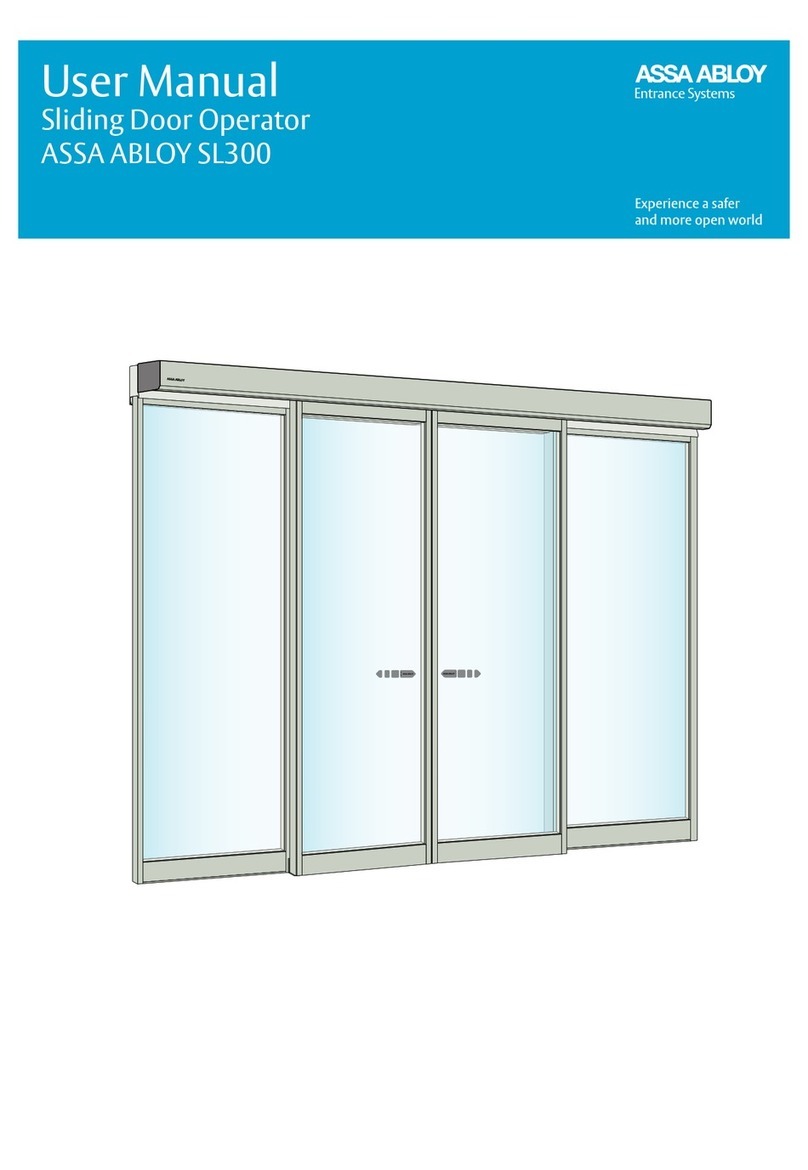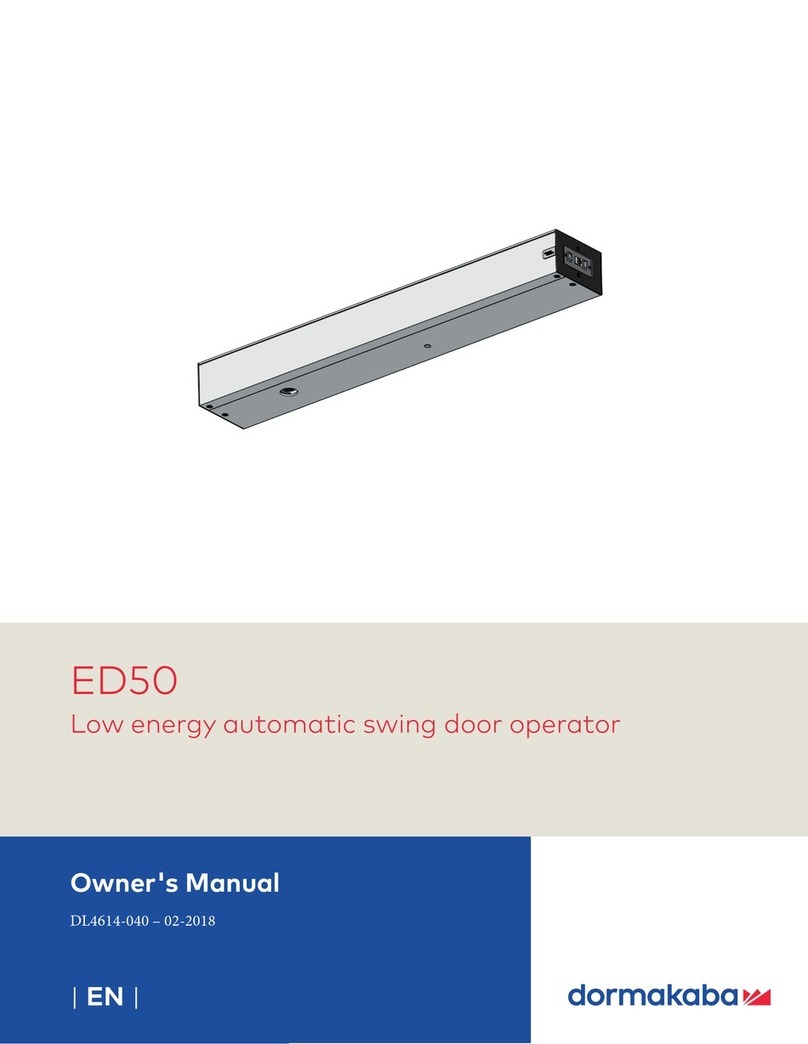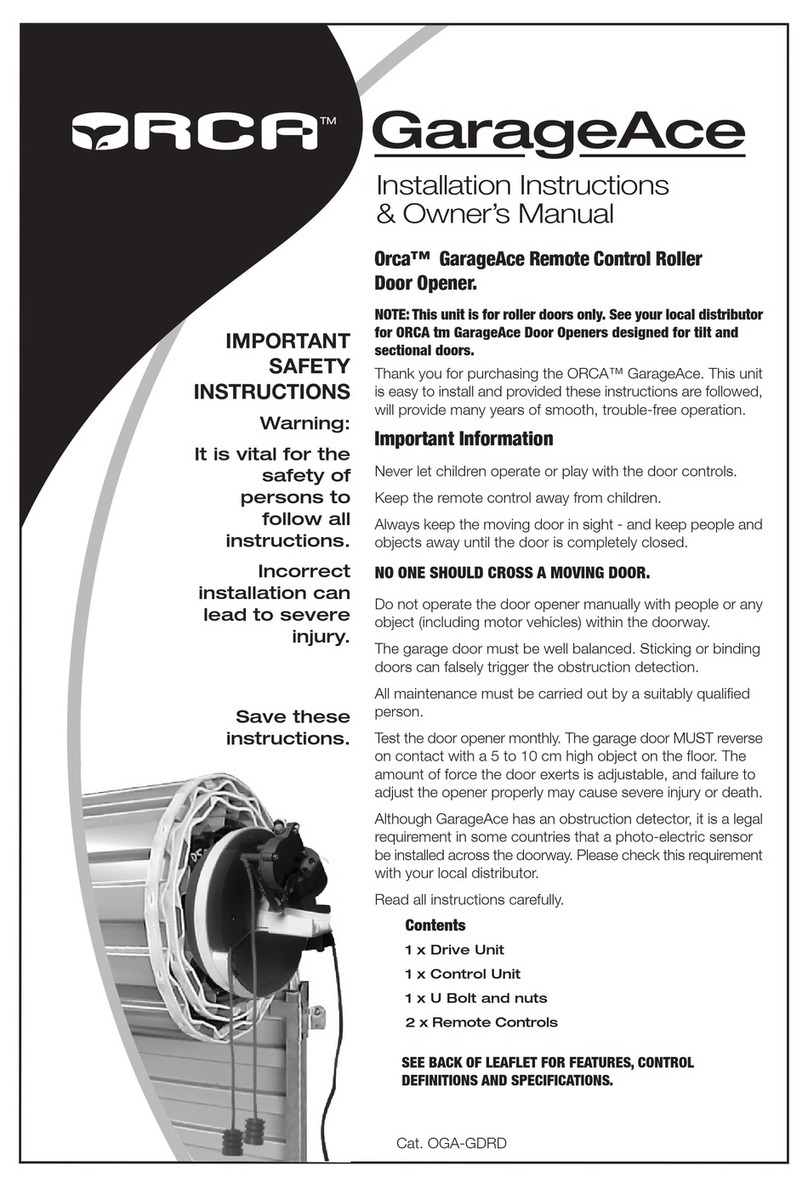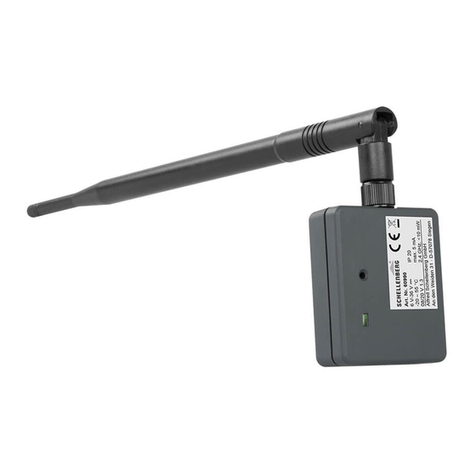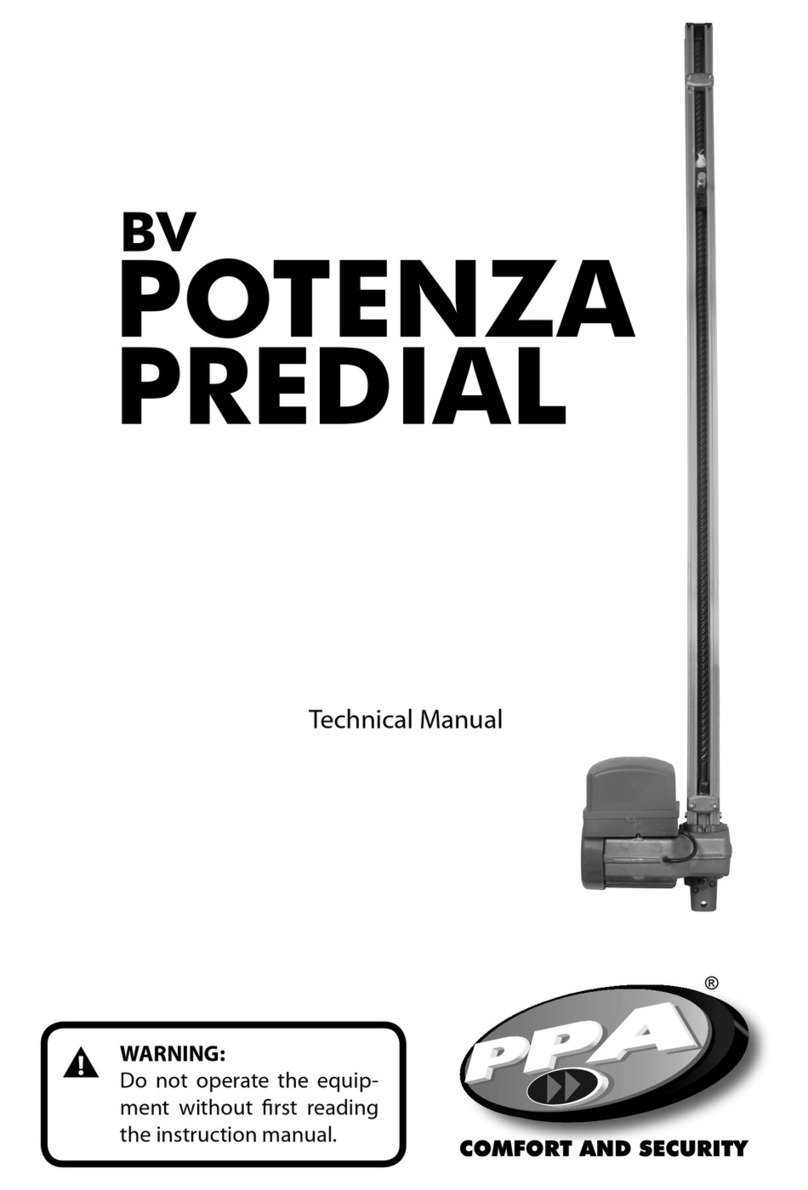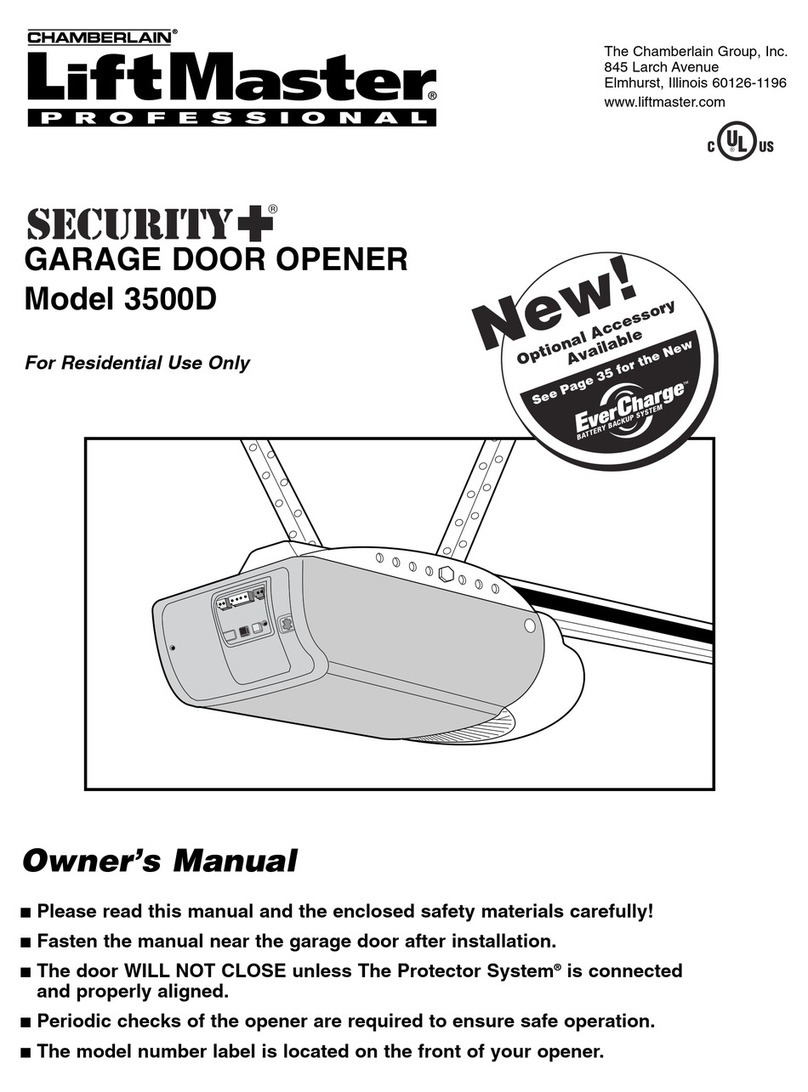tousek PULL TSA User manual

Mounting and istallation manual
Sliding gate opener PULL TSA
Safety Sensor

- 2 - tousek / EN_PULL-TSA_03 / 25. 03. 2020
Index
General warning and safety details ......................................................................................................................... 3
1. Features, general, function, techncal data ................................................................................................. 4
2. Installation ...................................................................................................................................................... 5
Technical layout of PULL TSA, general installation notes, warning note.................................................... 5
2.1 Installation of the motor .............................................................................................................................. 6
2.2 Installation of teh gear rack ........................................................................................................................ 7
2.3 Dismantling................................................................................................................................................. 7
3. Control board, layout of the control board.................................................................................................. 8
Warning notes - connection works............................................................................................................... 9
3.1 Clamp/terminal assignment........................................................................................................................ 9
3.2 Adjustments - overview, programming buttons ........................................................................................ 10
Stucture of the menu ................................................................................................................................ 11
3.3 Connections and adjustments ............................................................................................................. 12
P o Radio (radio programming) ..................................................................................................................... 12
P 1 Mounting direction ................................................................................................................................ 13
P 2 Impulse button ....................................................................................................................................... 13
Pedestrian button, STOP-contact............................................................................................................. 14
P3Photocells ............................................................................................................................................... 15
Photocells - examples of connection .................................................................................................. 15
P 4 Safety edges ( MSE-main , SSF- side safety edge) ............................................................................... 16
P5Max. force................................................................................................................................................ 16
P6ARS response time................................................................................................................................. 17
P7Soft stop way ......................................................................................................................................... 17
P 8 Operating mode...................................................................................................................................... 17
P9Prewarning time (blinking lamp: clamp 10/11)..................................................................................... 17
PAEnd position............................................................................................................................................ 17
PReset & Diagnosis ................................................................................................................................. 18
4. Emergency release in case of power failure (note for the user) ............................................................ 19
5. Exchangeoftheprolhalfcylinderlock ................................................................................................... 19
6. Commisioning ............................................................................................................................................. 20
7. Status dispaly .............................................................................................................................................. 21
8. Trouble shooting guide................................................................................................................................ 22
9. Cable plan .................................................................................................................................................... 24
10. Dimensioned drawing.................................................................................................................................. 25
11. List of the transmitter ................................................................................................................................. 26
Declaration of incorporation and conformity ........................................................................................... 27
This manual is the sole property of the TOUSEK Ges.m.b.H. and may not be made available to competitors. All rights reserved. No part of it may be reproduced without our prior
written permission. We will not accept liability for any claims resulting from misprints or errors. This edition of the manual replaces all earlier publications of the same.

tousek / EN_PULL-TSA_03 / 25. 03. 2020 - 3 -
Important warning and safety notes for minstallation and operation
• These installation and operating instructions form an integral part of the product “sliding gate operator”. They have been
specically written for professional installers trained and skilled in the trade and should be carefully read in their full length
before carrying out the installation. They describe the proper installation and operation of the sliding gate operator only,
not of the overall device “automatic gate”. After the installation this manual has to be handed over to the user.
• Installation, connection, adjustments, putting into operation, and servicing may only be carried out by trained profession-
als in full accordance with these installation- and operating instructions.
• Before carrying out works at the gate-system, the power supply has to be turned o.
• The EU Machine Directive, laws and rules concerning the prevention of accidents, and laws and standards which are in
force in the EU and in the individual countries have to be strictly followed.
• The TOUSEK Ges.m.b.H. cannot be held liable for any claims resulting from disregards of the laws and standards in
force during the installation and operation.
• The packaging materials (cardboard, plastic, EPS foam parts and lling material etc.) have to be properly disposed of
in accordance with the applying recycling- and environmental procection laws. They may be hazardous to children and
therefore have to be stored out of children´s reach.
• The product is not suitable for installation in explosion-hazardous areas.
• The product may only be used in accordance with its original purpose, for which it has been exclusively designed, and
which is described in these installation and operating instructions. The TOUSEK Ges.m.b.H. rejects any liability if the
product is used in any way not fully conforming to its original purpose as stated herein.
• Children have to be instructed, that the gate facility as well as the belonging parts may not be used improperly, e.g. for
playing. Furthermore handheld transmitters have to be kept in safe places and other impulse emitters as buttons and
switches have to be installed out of children‘s reach.
• Before beginning with the installation the installer has to make sure that all mechanical components of the gate facil-
ity, like carrier prole/rail, gate frame and panels, guiding elements etc. are suciently supportive and resistant for the
purpose of gate automation.
• All electrical installations have to be made in full conformity with the applying rules and laws (e.g. using a fault current
circuit breaker, proper grounding etc.).
• An all-pole disconnecting main switch with a contact opening-gap of minimum 3 mm has to be foreseen.
• The electric motor heats up during operation. Therefore the device should only be touched after it has cooled o.
• After installation the proper function of the gate facility and the safety devices has to be checked!
• The TOUSEK Ges.m.b.H. rejects any liability for claims resulting from usage of the product in combination with compo-
nents or devices which do not fully conform to the applying safety laws and rules.
• Only original spare- and replacement parts may be used for repair of the product.
• The installer has to inform the user about all aspects of the automatic operation of the complete gate facility, as well as
about emergency operation. The installer further has to supply to the user all instructions relating to the safe operation
of the gate facility. The installation and operating instructions also have to be handed over to the user.
• Please notice that the warranty will not be applicable if the label with the engine number has been removed or
damaged.
Maintenance
• Maintenanceworksmayonlybecarriedoutbyqualiedpersonnel.
• The maintenance of the entire system must be carried out according to the instructions of the installer.
• Check the proper function of the power-operated shutdown monthly.
• Check the proper function of the emergency release mechanism periodically.
• Check if all mounting screws are securely fastened periodically.
• Remove dirt deposits from the operator and gear rack periodically.

- 4 - tousek / EN_PULL-TSA_03 / 25. 03. 2020
Features of PULL TSA
• Programmable via four buttons and 7-segment display
or optionally via LC-Display (2 x 16 characters)
• Three selectable operating modes (impulse, automatic
and dead man)
• Event memory oft he last 800 cycles
• 1m partial opening for pedestrians (can also be operated
via radio)
• Built in control board in separate housing
• Self-learning end positions
• Permanently selearning force
• Safety system ARS (automatic reversal system)
• Direct connection of 8,2 kΩ safety sensing edges
separated for main and side edge
• Adjustable soft stop
• Integrated radio receiver RS 868
• Up to 48 transmitters can be programmed
•
Memory oft the radio receiver manageable from the display
• Optional releasing system with standard half cylinder
• Gearbox unit in oil bath
• Worm gear and worm wheel made of tempered steel
•
1. General Sliding gate opener PULL TSA
Technical data
Schiebetorantrieb
PULL TSA - Set
Control board integrated Max. drive 30m
Power supply 230Va.c. 50Hz Duty cycle in
S3 mode 20 cyles/day
max. current consumption (excl. equipment)
1,3A Ambient temperature -20° bis +40°C
Gear wheel Z20M4 Protection class IP44
Max. gate weight 400kg torque sensor
Speed 11m/min Article code 61001
Torque 15Nm
Kit accessories 1 motor PULL TSA with integrated receiver RS 868, 2-channel • 2 transmitters RS 868-4M,
4-channel • 1 photocell LS 180
Optional equipment Programming display incl. 20cm cable • half profile cylinder with 3 keys
General
While developing the new operator generation Tousek PULL TSA special attention has been paid to a quick and simple instal-
lation and a troublefree operation, together with the proven quality and reliability. Accordingly, many clever details have been
built into the operator - from the automatic learning of gate end positions, to the control board with removable clamps, which
make it particularly user-friendly. The drive unit itself consists of an electric motor and a worm gearing, accommodated in a
robust aluminium housing, and - together with the integrated microprocessor control incl. 2-ch. Radio receiver RS 868 and the
safety reverse system ARS - forms a compact device with small overall dimensions.
The safety reverse system ARS senses obstacles during opening and closing of the gate and permits a continuous adjustment of
the drive force. Following the Tousek tradition, all operator components have been built in a particularly robust and resistant way to
guarantee the safe and reliable operation even in the most adverse weather conditions.
Additional improvements are for example:, the separate control board housing, which double protects this sensible part, or the oil
bath, which ensures that the motor/gearing components move in an optimal way in all temperatures with perfect lubrication and
cooling eect. You can install the PULL TSA on new or already exsting sliding gates in a simple and fast way.
optional programming display incl.
20cm cabel (art.code 12111250)

tousek / EN_PULL-TSA_03 / 25. 03. 2020 - 5 -
10 1
1a
3
5
5a
7
8
6
11
2
40
30
optionalhalf cylinder (PHZ)
with 3 keys (Art.code13300220)
44a
Technical layout PULL TSA
2. Installation Sliding gate opener PULL TSA
General installation notes
Before installing the Tousek PULL TSA sliding gate operator we recommend checking the following points:
• Checking the gate structure:
Ifthegateslidesonoorrails,pleasecheckthebottomrollersandtheupperguiderollersandmakesurethat
there is no undue friction or jamming. In caso of a cantilever gate please check if the gate can be moved out of
itsend-positionswithoutundueeort.
• The gate must travel in a stable manner without any lateral movements..
• Make sure that the gate travels in a regular way without undue friction or jamming along the whole travel length.
• Make sure that there are stoppers at both ends of the track, preventing the gate from running over its travel limit.
ATTENTION !
• Attention: Mechanial limit stops are absolutely necessary!
• Attention: The sliding gate operator PULL TSA ias been developed and designed for the automation of hori-
zontally travelling sliding gates. Gates on sloping tracks (i.e. gates which follow an inclined, non-horizontal,
travel path) must not be automated without additional safety devices (which make sure that the gate cannot
start moving on its own from any gate position).
(1) Lockable emergency release with optional
half-prole cylinder (1a)
(2) Gear wheel Z20
(3) Cable ttings
(4) Ground plate
(4a) Slotted holes (4x) for mounting on the foundation
(5) Control board with integrated receiver
(5a) Motor cover
(6) earthing screw
(7) Sensor
(8) Motor-/gear unit
(10) Threaded hole to fasten the motor cover (11)

- 6 - tousek / EN_PULL-TSA_03 / 25. 03. 2020
NOTE concerning cable laying
• The electric cables have to be laid in insulating sleeves which are suitable for underground usage. The insulat-
ing sleeves have to be lead into the inner of the operator housing (see picture).
• 230V cables and control lines have to be laid in separate sleeves.
• Only double-insulated cables, which are suitable for underground usage (e.g. E-YY-J) may be used.
• In case that special regulations require another type of cable, cables according to these regulations have to be
used.
2.1 Installation of the motor Installation
(1) lockable emergency release with
optional half-prole cylinder
(2) gear wheel
(3) cable exit
(4) ground plate
(4a) slotted holes (4x) for connection on
the ground
(Z) steel gear rack
After installing the protection tubes (check cable exit of operator (3)) and having nished the concrete foundation,
the motor has to be bolted through the 4 slotted holes (4a) to the concrete foundation. It is particularly important that
the operator is mounted parallel to the gate panel, and that the measurements given in the drawing are kept.
4
gear wheel:
Z20M4: r44
119
25
Z
61
1
210,2
22
6,4 124,1
2
Foundation
216
3039,3
58,3
37
46
11
4a
4 3

tousek / EN_PULL-TSA_03 / 25. 03. 2020 - 7 -
~1mm
Attention
• Do not weld the individual gear rack elements
together!
• Release the operator (see emergency release) and open
the gate completely.
• Install the spacer tubes (D) with the help of the bolts and
washers on the rst meter of gear rack.
• Make sure that the bolts/screws sit in the top end of the
vertical slots (L), then tighten them..
• Place the rst gear rack element on the drive pinion and
x it in place with a screw clamp.
• Move the gate by hand until reaching the end of the rst
gear rack element, then weld the rst, second, and third
spacer tube to the gate.
• Proceed with the other gear rack elements in the same
manner.
• Beforexingthesecondmeterofgearrackitises-
sential to place another gear rack element under the
rstandsecondgearrackelements,therebymaking
sure that the gearing module between the two gear
rack elements will be exactly kept (see illustration).
• After installation of the gear rack please loosen the
fastening bolts slightly and rise the gear rack a little
along the vertical slots, creating a distance of approx.
1 mm between the drive pinion of the operator and
the gear rack.
• In case of gear rack elements installed without welding,
please screw them to the gate frame together with the
spacer tubes.Apart from that the gear rack elements have
to be installed in the same manner.
2.3 Dismantling
The dismantling of motor is made the other way around of mounting.
Beforedismantlingpleaseplugopowersupplyofmotor!
2.2 Installation of the gear rack Installation
L
D

- 8 - tousek / EN_PULL-TSA_03 / 25. 03. 2020
Achtung
During connection, adjustment and
maintenance works please take care,
that the electronic circuit board won´t be
damaged by moisture (rain).
Overview of the control unit
3. Control board Sliding gate opener PULL TSA
Elements of control board
(K) Terminal blocks
(KM) Motor clamps
(FE) Integrated radio receiver
(A) Antenna plug
(D) Display plug
(S) Sensor plug (on the back side)
(7S) 7-Segment display
(TA) Programming buttons (+, -, ESC und ENTER)
(F) Fuse 3,15A T
Grounding
connection
Grounding
The grounding connection is done
in the operator housing by means
of the designated grounding screw!
FE
7S
D
KM
F
K
TA
A
blue
black
red
–
ESC ENTER
+
S

tousek / EN_PULL-TSA_03 / 25. 03. 2020 - 9 -
3.1 Terminal assignment Sliding gate opener PULL TSA
Power supply
230V a.c.
Blinking lamps
230V, max. 100W
Photocell contact
Common PTC-contact
Power supply photocell receiver
Power supply photocell transmitter
Common PTC-power supply
Main safety sensing edge
Side safety sensing edge
Common contact safety edge
Pedestrian-switch
Common
impulse-switch
STOPcontact
Common
blue
Motor connection
black 230Va.c.
red
pre-wired
84
8.k2
8.k2
When the gate is in its CLOSED
position (ready for operation) the
terminal 40/41 get switched into po-
wer saving mode (i.e. no current)
52
51
50
34
30
32
31
30
1
N
10
11
L
N
L
N
Warning notes
• Beforetakingothecontrolcover,
themainsswitchmustbeturnedo!
• If the control is power supplied, its inner part is under
tension.
• In order to avoid electrical strokes, the safety regula-
tions have to be kept.
• The device may only be connected by trained profes-
sionals.personal anzuschließen.
• The product is not suitable for installation in explosion-
hazardous areas.
• An all-pole disconnecting mains switch with a contact
opening gap of min. 3 mm has to be foreseen. The
gate facility has to be secured according to the valid
safety regulations!
• IMPORTANT: The control lines (buttons, radio, pho-
tocells, etc.) have to be laid separately from the 230V
lines (supply line, motors, signal lamp).
46
45
43
41
40
-
-
+24V
=
24V
=
The stop input has no emergency stop function! - In order to ensure the emergency stop function, provide
the supply line with an all-pole disconnecting emergency stop switch, that locks after actuation!

- 10 - tousek / EN_PULL-TSA_03 / 25. 03. 2020
The selectable parameters of the menu items P o to Pare marked in the table below as follows:
= selectable settings (value assignment possible) = factory settings
Programming buttons Adjustmets-overview
3.2 Adjustments - overview Sliding gate opener PULL TSA
• Before programming please remove the motor cover.
• Die Anzeige (either 7Segment- (7S) or optional, external
display) informs you about operating status, chosen menus
and the adjustment of various parameters.
• The programming of the control is carried out with the help
of four buttons (+, -, (=Enter) and (=Escape).
• Scrolling through the available menu points (up/
down) or the adjustment of a parameter (value in-
crease/decrease) is carried out with buttons + and –.
AUTO-COUNT: when holding one of the buttons the value
changes automatically.
• When pressing the -button a conrmation for entering
the shown menu point, resp. for accepting the shown value
of a parameter is given.
• When pressing the -button you return to the superior menu point. Possibly changed adjustments of a parameter
are rejected with this button (the former values remain valid).
• AUTO-EXIT: if no button is pressed within1 min., the menu switches automatically to the modus “ready for operation”
(without saving the changed parameters).
Alternatively to the programming of the motor via standard control panel, consisting of 4 programming buttons
and a 7-segment display (7S), you can also connect the optional text display to the control unit (connector (D)).
The indications are given in written form and this thereby facilitate the operation.
7S
If the optional clear text display is connected, the programming buttons of the default panel are out of
operation!

tousek / EN_PULL-TSA_03 / 25. 03. 2020 - 11 -
Main layer Settings
LED display Menu items LED dis-
play
Settings
P0
see page 12
radio 0
1
2
3
learn impulse
learn partial opening
delete individu.
delete all (no)
(yes)
P1
see page 13
mounting direction 0
1
<<<--- left
--->>> right
P2
see page 13
impulse button 0
1
2
3
4
OPEN/STOP/CLOSE
OPEN/CLOSE/OPEN
OPEN abort PT
OPEN extend PT
DEADMAN FUNCTION
The selected
setting applies
to both - impulse
and pedestrian -
buttons
P3
see page 15
photocells 0
1
2
3
not active
reverse during closing
Stop - after release open
during clos.stop then closing
P4
see page 16
safety edges 0
1
2
3
not active
only main edge
only side edge
MSE and SSE
P5
see page 16
max. force 0–9 0 (weaker) ...9 (stronger) = 7
P6
see page 17
ARS-response time
0–8 0 (sensitive) ...8 (insensitive) = 4
P7
see page 17
soft stop way 0–9 0 (x 10cm) ...9 (x 10cm) soft stop way = 5 (x10cm)
P8
see page 17
operation mode 0
1
2
3
4
5
6
7
8
9
impulse mode
aut. closing 5s
aut. closing 15s
aut. closing 30s
aut. closing 45s
aut. closing 60s
aut. closing 90s
aut. closing 120s
aut. closing 300s
aut. closing 600s
P9
see page 17
prewarning time 0
1
2
switched o
4s only CLOSE
4s OPEN and CLOSE
PA
see page 17
end position 0–9 0...9 = 5
Pb
see page 18
reset & diagnosis b0
b1
b2
b3
b4
delete position (No)
(YES)
factory setting (No)
(YES)
status display
sensor status (0 … 32 … 63)
PHC test 1 (active)
0 (not active)
Note: some adjustments regarding function or operating logic can only be executed if the gate is closed
and the display shows the status „ready for operation“
.
Menu structure Adjustmets-overview
ESC ENTER
+
–
integrated control for slider PULL TSA

- 12 - tousek / EN_PULL-TSA_03 / 25. 03. 2020
WARNING:Always follow the warning notes listed on page 9!
Integrated radio receiver RS 868, 2-channel
• The integrated radio receiver is provided with a self-learning technology, ie the
coding of the transmitter is learned into the receiver.
• Every time that a command is given, the coding gets altered by the transmitter
(rolling code). Thanks to this permanent change, each code is used only once
and thus an abusive use of the code by scanning is excluded.
• The receiver memory can store max. 48 transmitters. This means that all the
buttons which are programmed with the function „impulse“ or „partial opening“get
stored under the same number. IMPORTANT: Make note of the numbers
shown on the display during programming procedure!
• When the receiver memory is full by any attempt of programming a transmitter
button, 3 sec. long and consecutive beeps are emitted.
Antenna
• An 8.5cm long piece of wire at the terminal strip (A) is connected
to the antenna pole connection of the receiver.
• Do not change the length of this piece of wire (loss of range)!!
• In order to achieve longer range the antenna FK 868 is optionally
available.
Antenna FK 868
(optional)
3.3 Connections and adjustments Sliding gate opener PULL TSA
Radio Connections and adjustments
P0 Radio Buttons/ switches
o learn impulse: After conrming by pressing the
ENTER button, the transmitter emits a continuous
tone of approx. 10 sec.Press the transmitter buttons
that have to be programmed within these 10 seconds.
The successful storage process is signaled by a
rapid succession of tones.
Important: Make a note of
the memory position / number shown on the display
(needed for deleting process). transmitter list page 26.
SUGGESTION: with the function „pro-
gramm impulse transmitter“ you can also
see on the display the position of an already
memorized transmitter. When you hear a
continuous tone press the button P3, loca-
ted on the back side of the remote control
(eg with a paper clip.)
1 learn partial opening: After conrming by pressing
the ENTER button, the transmitter emits a continuous
tone of approx. 10 sec. Press the transmitter buttons
that have to be programmed for the partial opening
within these 10 seconds. The successful storage
process is signaled by a rapid succession of tones.
Important: Make a note of the memory position /
number shown on the display (needed for deleting
process). page 26.
2 Delete individual transmitter: After selecting with the ENTER key, the occupied memory locations are displayed.
Scroll through with the buttons + - through this list until the memory location (number) displays the desired hand-held
transmitter. With conrmation by the ENTER button of the remote control in question is completely extinguished, ie
all programmed keys of the remote control.
3 delete all: NO: do not delete the transmitters.
YES:alltheprogrammedremotecontrolsgetdeletedafterconrmingwith Enter.
FE
A
z.B.
innerhalb
10 Sekunden !
Enter
1
Learn partial opening:
P3
z.B.
innerhalb
10 Sekunden !
Enter
o
Learn impulse:
Determine memory position
of an already memorized
transmitter:
Backside of the
transmitter

tousek / EN_PULL-TSA_03 / 25. 03. 2020 - 13 -
Pushbuttons, key switches as well as external radio receivers with potential free make contacts can be used as
impulse emitters.
P2 Impulse button (terminals 30/32) Buttons / switches
o OPEN/ STOP / CLOSE impulse repetition (fac-
tory settings): After a command give with the impulse
switch the motor starts an open or close movement. If
the impulse switch is pressed again during this move-
ment, the motor stops. With the next command, the
motor drives in the opposite direction of the last gate
movement.
1 OPEN / CLOSE / OPEN impulse repetition: After
a command of the impulse switch the motor starts
an open or close movement. If the impulse switch
is pressed again during this movement, the motor
reverses.
• In this operation mode it is not possible to stop the motor with the impulse switch – it always
travels until reaching an end position. (Opened or closed position).
• for the function OPEN/CLOSE/OPEN we strongly suggest the installation of a photocell!
2 OPEN abort pause time: With the impulse button you can only open the gate. It is not possible to close the gate
during opening, by means of the impulse button. Only when the gate is open it is possible to terminate the pause
time by giving an impulse. This causes an immediate closing movement.
3 OPEN extend pause time: Only opening commands are accepted from the impulse button: ie it is not possible
to close the gate via impulse button. When the gate is open the impulse button extends the pause time. The gate
closes automatically after pause time.
4 DEAD-MAN: The motor opens as long as the impulse switch is pressed – closing the gate with the impulse switch
is not possible. As soon as the switch is released, the gate stops. For safety reasons, once the deadman setting
is selected, the radio receiver is put out of function.
• If the impulse button is set on dead man operation, then automatically also the partial opening button
will be on deadman operation. the gate will be opened by means of the impulse button and closed with
the partial opening button.
• IMPORTANT: do not carry out commissioning in dead man modus. If desired, select this func-
tion only after commissioning (see page 20).
Impulse button
(e.g. key switch EPZ 1-2T)
2P1
30
32
LEFT
RIGHT
Mounting direction Connections and adjustments
P1
o <<<--- left: seen from the inside, the gate opens to the left.
1--->>> right: Seen from the inside, the gate opens to the right.
Buttons/switches Connections and adjustments

- 14 - tousek / EN_PULL-TSA_03 / 25. 03. 2020
STOP button
(e.g. switch KDT-1N)
31
30
Pedestrian opening button (terminal 30/34) Buttons/ /switches
•Upon actuation of the partial opening button the gate
carries out xedpartialopeningofapprox.1m.
•The partial opening button has automatically the
same function selected for the impulse button (menu
item P2).
partial opening button
(e.g.. key switch EPZ 1-1T)
P1
34
30
As impulse emitters you can use push-buttons or key switches as well as external radio receivers with potential
free contacts.
Important
As stop switch a break contact has to be used.
If no stop switch is connected, terminals 31/30 have to be wire-bridged.
31
30
The stop input has no emergency stop function! - In order to ensure the emergency stop function, provide
the supply line with an all-pole disconnecting emergency stop switch, that locks after actuation!
STOP-contact (terminal 31/30) Buttons / switches
•as soon as you press the stop button the gate stops in
any desired position.

tousek / EN_PULL-TSA_03 / 25. 03. 2020 - 15 -
Important
At the control of the PULL TSA can be connected only
one photocell LS 180 (included in the kit).
Important
• If no photocell is used, please deactivate the input ( „not active“).
Photocells - connection examples
Photocells Connections and adjustments
P3 Photocell (Contact: terminals 45/46)
0 not active: the safety device “photocell”is not evaluated.
1 Reverse during closing: an interruption of the photocell during closing makes the gate reverse (open). When
in automatic mode the gate closes as soon as the pause time has run out. When in impulse operation you have to
give another closing command.
2 Stop - after release open: an interruption of the photocell beam during opening or closing movement makes the
motor stop as long as the photocell is interrupted. After releasing the photocell, the gate opens. In automatic mode
the gate closes as soon as the pause time has run out. When in impulse operation you have to give another closing
command.
3 During closing stop, then closing: an interruption of the photocell during closing movement makes the motor
stop as long as the photocell stays interrupted. After releasing the photocell, the gate closes.
Tousek Photocell LS 180
as safety device
Photocells
• The control unit has a power supply connection for a 24V d.c. photocell (LS):
• supply LS-transmitter: terminals 40(+)/41(-) / supply LS-receiver: terminals 40(+)/43(-).
• Note: in „gate closed“ position the terminals 40/41 are being switched into energy saving mode - no current!
• By powered and positioned photocells the contact must be closed (NC).
• Connection of photocells contact: terminal 45/46
• Photocell self-test function: The control unit has a monitoring function for the connected photocells. A test is triggered
by each impulse and will be checked if the receiver of the photocell responds to the signal from the photocell transmit-
ter. If there is no communication between the photocell receiver and transmitter the control unit responds with an error.
The deactivation of the self-test function is only allowed if the safety installations correspond to the category 3 !
• Function of the photocell: If the photocell gets triggered during the closing movement, this causes an inversion of the
of gate movement. An interruption during opening movement has no effect.
• Detailed information in the corresponding photocell manual.
-
-
+
Transmitter Receiver
N.O.
COM
N.C.
46
45
43
41
40

- 16 - tousek / EN_PULL-TSA_03 / 25. 03. 2020
Important
• select the setting according to the carried contact strips connections!
• During the learning phase of the motor the contact edges shouldn´t be triggered, since this would lead to an
error message - the end stops have to be set accordingly.
Important
• The motor stops when max. set force is exceeded.
• WARNING: The safety regulations about the force settings must be observed!
Safety edges Connections and adjustments
P4 Main safety edge (terminal 50/52), side safety edge (terminal 50/51)
0 not active : the safety devices “closing edges” are not evaluated.
1 only main edge: main safety edge gets evaluated.
2 only side edge: side safety edge gets evaluated.
3 MSE and SSE: main and side safety edge get evaluated.
Safety sensing edges (main and side edge)
• OBSTACLE DETECTION:
when a contact strip/safety edge is triggered/activated
then a change of direction is eected for 1 second.
After that the gate stops.
i.e.: Hence if the safety edges have to react to obstacles during the closing movement, they have to be serially
connected to the terminals of the main safety edge
If the safety edges have to react to obstacles during the opening movement, they have to be serially connected
to the terminals of the side safety edge
Example: W 8,2kΩnalresistance
1 naledge
2+3 passage edge
S to control board
If you connect only one safety edge please use a nal edge (1).
Side safety edge
Function: safety during
opening movement
Main safety edge
Function: safety during
closing movement
1
W
2 3 S
50
52
50
51
main safety edge
side safety edge
Main safety edge
Side safety edge
52
51
50
8.k2
8.k2
Max. force Connections and adjustments
P5 factory settings: 7
0– 90–9 adjustable: denes the max. permissible motor force
(0 =min., 9 = max.)

tousek / EN_PULL-TSA_03 / 25. 03. 2020 - 17 -
ARS-response time Connections and adjustments
P6 factory setting : 4
0– 80–8 adjustable: denes the response of the AR system.
(0 =max. sensitivity, 8 = min. sensitivity)
Soft stop way Connections and adjustments
P7 factory setting: 5
0– 90–9 adjustable: determines the route of the soft stops. This results approx. from
the value shown in the display multiplied by 10. i.e.: the factory setting (= 5) results in a
softstopp length: 5 x 10cm = 50cm.
Signal lamp
• A signal lamp can be con-
nected to the terminals 10/11
(230V, max. 100W).
10
11
L
N
P9 (Blininkg lamps: terminals 10/11)
oswitchedo
14s prewarning when closing
24s prewarning when opening and closing
Prewarning time Connections and adjustments
End position Connections and adjustments
PA factory setting: 5
0– 90–9 adjustable: used to readjust the automatically detected end positions of the gate (e.g. for safety sens-
ing edges). When the value is „0“ the motor runs to the previously learned end positions. In order to have
a shorter drive distance, this value can be extended to up to 9, which means a reduction of approx 200mm
for both nal positions
This adjustment is ONLY adopted when the gate is CLOSED.
P8
0 Impulse mode:
to start the closing movement of the gate, an impulse given by impulse emitter is necessary.
1– 9autmatic closing (see table): gate closes automatically after the adjusted pause time.
Exception: If the gate is in partial open position and an impulse for complete opening arrives then the gate
opens completely and after the pause time it returns to partial opening position.
Pause time 0
1
2
3
4
5
6
7
8
9
Impulse mode
aut. closing 5sec
aut. closing 15sec
aut. closing 30sec
aut. closing 45sec
aut. closing 60sec
aut. closing 90sec
aut. closing 120sec
aut. closing 300sec
aut. closing 600sec
Operation mode Connections and adjustments
Ausnahme: Bendet sich das Tor in der Teilönungsposition und das Tor wird über einen Befehl komplett geönet, so wird, nach Ablauf
der Pausezeit, das Tor nicht geschlossen, sondern wieder die Gehtürposition angefahren.

- 18 - tousek / EN_PULL-TSA_03 / 25. 03. 2020
In this manual the factory settings
of the each menu item are marked
with .
The mech. stops should be set so
that ev. existing contact strips are
not triggered, since this would lead
to an error message.
Reset & Diagnosis Connections and adjustments
Attention
• The photocell test can be suppressed by selecting „not active“.
• The deactivation of the self-test function is only permitted if the safety equipment correspond to the
category 3.
o Delete position:
NO: do not delete the end positions.
YES: the detected end positions of the motor will be
deleted after conrming ( Enter).
After giving an impulse the end positions get recalculated.
1 Factory setting:
NO: no resetting to factory settings.
YES: Reset to factory settings and delete of the de-
tected end positions. The end positions are recalculated
after giving an impulse.
2 Status display: status display of the following inputs on certain segments of the 7-segment display:
Segment lights up:
Input OK S
R
ME
SE
I
P
PH
D
Segment doesn´t light up:
Input triggered or not OK
S Stop button IImpulse switch ME Main safety edge PH Photocell
R Sensor active PPartial opening button SE Side safety edge DDisplay connected
Status shown on the optional display:
$not triggered $-triggered $xsafety sensing edge interrupted $onot active
e.g.:
$$$$$$$$$$$$$$$$
$$$$$$$$$$$$$$$$
I P S PH ME SE R $$$$$$$$$$$$$$$$
$$$$$$$$$$$$$$$$
I P S PH ME SE R
All inputs ok. Impulse-,partial opening button not triggered.
STOP-button and photocell triggered.
Contact edge (main contact edge) interrupted
Contact edge (side safety edge) shortcircuited.
Sensor active.
3 Sensor status (0 ... 32 ... 63) < only display function: Signal strength of the speed sensor is displayed on
the display.
4 PHC-Test:
1 active: the photocell test is performed by giving an opening impulse (button, remote) when the gate is
in its closed position.
0 not active: photocell test is not performed.

tousek / EN_PULL-TSA_03 / 25. 03. 2020 - 19 -
The handle in picture shows the unlocked position
In case of a power failure or other defect the motor can be
disengaged from the gearmotor as follows::
• Switchopowersupply
• Slide key-cover (A) slightly to the front and turn it away.
Insert the key and turn it clockwise to its limit stop (the
emergency release mechanism can be key-locked both
in the engaged and in the disengaged position).
• Turn the handle 180° counter-clockwise (viewed from
above). The gate can now be manually opened or closed.
Re-engaging the emergency release mechanism:
To return to normal motor operation please turn the handle
back to its original position (i.e. 180° clockwise)
Wichtig
•
after bringing the handle is back in normal position,
slowly move the gate manually in its travel direction,
until you can hear that the gearing has re-engaged!
Then lock again and remove the key.
With the next impulse the motor searches its open position
(do not need to programm the end positions again).
4. Emergency release in case of power failure (note for the user) PULL TSA
H
A
• Turn the cylinder protection cap down.
• Insert the key into the cylinder that has to be installed and
rotate the locking lug, so that the lock can be pushed into
the actuator.
• Remove the protective cap and secure the cilinder with
the screw (S). Then replace the protective cap.
• To re-insert the cylinder please carry out the above steps
in the reverse order. S
5. Exchangingthehalfproecylinderlock Sliding gate operator PULL TSA

- 20 - tousek / EN_PULL-TSA_03 / 25. 03. 2020
Important: preparation works
• Connect control panels, safety devices to the motor under the safety regulations in .
Attention: if no stop switch is connected then the terminals 30/31 have to be bridged.
• The mechanical limits have to be placed so that contact edges are not triggered, as this would lead to an error
message
• Unlock emergency release of operator and set gate to half-opened position. Then lock the operator again.
• Switch on the system (assuming correct connection).
• Important: the commissioning has to be carried out in impulse mode (default setting) and not in deadman mode.
6. Commissioning Sliding gate opener PULL TSA
00 YES
switch on conrm
learn-/delete function
conrm
function?
NO
--
change? YES
change? YES
detecting
open-position
ready for
operation
Setting of the
parameters
Setting of the
parameters
change? YES
Radio programming
according the
selected function
00 YES
conrm?
current
setting
settings
OK?
NO
Setting of the
parameters
change? YES
P A
P 0
P 1
P 2
H 8 H 9
detecting
closed-poition
Radio
Mounting direction
Impulse button
End position
Table of contents
Other tousek Garage Door Opener manuals
